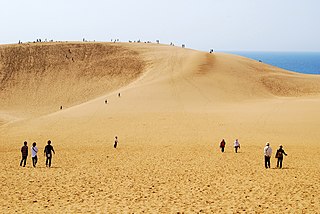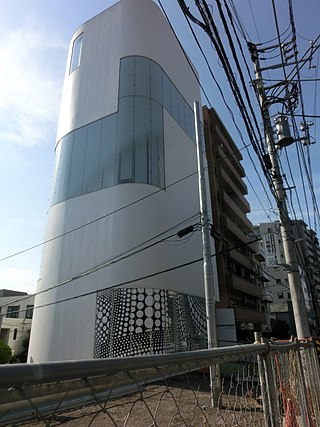
The Yayoi period started in the late Neolithic period in Japan, continued through the Bronze Age, and towards its end crossed into the Iron Age.

Tottori Prefecture is a prefecture of Japan located in the Chūgoku region of Honshu. Tottori Prefecture is the least populous prefecture of Japan at 538,525 (2023) and has a geographic area of 3,507.13 square kilometres (1,354.11 sq mi). Tottori Prefecture borders Shimane Prefecture to the west, Hiroshima Prefecture to the southwest, Okayama Prefecture to the south, and Hyōgo Prefecture to the east.

Magatama are curved, comma-shaped beads that appeared in prehistoric Japan from the Final Jōmon period through the Kofun period, approximately 1000 BCE to the 6th century CE. The beads, also described as "jewels", were made of primitive stone and earthen materials in the early period, but by the end of the Kofun period were made almost exclusively of jade. Magatama originally served as decorative jewelry, but by the end of the Kofun period functioned as ceremonial and religious objects. Archaeological evidence suggests that magatama were produced in specific areas of Japan and were widely dispersed throughout the Japanese archipelago to the Southern Koreanic kingdoms via trade routes.

Yayoi Kusama is a Japanese contemporary artist who works primarily in sculpture and installation, and is also active in painting, performance, video art, fashion, poetry, fiction, and other arts. Her work is based in conceptual art and shows some attributes of feminism, minimalism, surrealism, Art Brut, pop art, and abstract expressionism, and is infused with autobiographical, psychological, and sexual content. She has been acknowledged as one of the most important living artists to come out of Japan, the world's top-selling female artist, and the world's most successful living artist. Her work influenced that of her contemporaries, including Andy Warhol and Claes Oldenburg.
Mayako Nigo is a Japanese voice actress from Tokyo, Japan. She was married since April 2014 and that she has given birth to a boy on January 1, 2016.
Yayoi (弥生) is a neighbourhood in Bunkyo, Tokyo. In 1884, when it was part of Tokyo City, it was the location of a shell mound where a new type of pottery was discovered by Shogoro Tsuboi and his colleagues. The pottery became known as Yayoi, and eventually a period of Japanese prehistory was named after the neighborhood where the type site was excavated.

Yoshioka Yayoi was a Japanese physician, educator, and women's rights activist. She founded the Tokyo Women's Medical University in 1900, as the first medical school for women in Japan. She was also known as Washiyama Yayoi.

The Japanese destroyer Mutsuki was the name ship of her class of twelve destroyers built for the Imperial Japanese Navy (IJN) during the 1920s. During the Pacific War, she participated in the Battle of Wake Island in December 1941 and the occupations of New Guinea and the Solomon Islands in early 1942. Mutsuki was one of the escorts for the invasion force during the Battle of the Coral Sea in May and then participated in the Guadalcanal Campaign later that year. The ship was sunk by American bombers during the Battle of the Eastern Solomons in August.

Sadamichi Kajioka was an admiral in the Imperial Japanese Navy during World War II. He directed Japanese forces involved in the Battle of Wake Island.

Yayoi is a feminine Japanese given name.

The Mutsuki-class destroyers were a class of twelve destroyers of the Imperial Japanese Navy. All were given traditional poetic names of the months of the year by the Lunar calendar or phases of the moon. Some authors consider the Kamikaze and Mutsuki-class destroyers to be extensions of the earlier Minekaze class.

The Japanese destroyer Mochizuki was one of twelve Mutsuki-class destroyers, built for the Imperial Japanese Navy (IJN) during the 1920s. During the Pacific War, she participated in the Battle of Wake Island in December 1941 and the occupations of New Guinea and the Solomon Islands in early 1942.

The Japanese destroyer Yayoi was one of twelve Mutsuki-class destroyers built for the Imperial Japanese Navy (IJN) during the 1920s. During the Pacific War, she participated in the Battle of Wake Island in December 1941 and the occupations of New Guinea and the Solomon Islands in early 1942.
Two destroyers of the Imperial Japanese Navy were named Yayoi:

The Ōzakai cave dwelling is an archaeological site consisting of a cave dwelling in the Ōzakai neighborhood of the city of Himi, Toyama Prefecture in the Hokuriku region of Japan. The site was designated a National Historic Site of Japan in 1986.

The Yayoi Kusama Museum is a contemporary art museum in Tokyo, Japan, dedicated to the work of the Japanese artist Yayoi Kusama. The museum is located in the Shinjuku Ward, in the western suburbs of Tokyo.
Nichiai Maru (Japanese:日愛丸) was a transport of the Imperial Japanese Army during World War II.
Yayoi Urano is a retired Japanese Wrestler and Judoka. She won six gold medals and one silver medal in three weight classes at the World Wrestling Championships from 1990 to 1996.
This page is based on this
Wikipedia article Text is available under the
CC BY-SA 4.0 license; additional terms may apply.
Images, videos and audio are available under their respective licenses.











